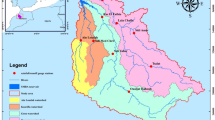Abstract
Purpose
We investigated the application of Kohonen Neural Networks (KNNs) in order to estimate sediment yield based on runoff and climatological data in a semiarid region of Brazil. Accurate estimations of sediment yield are essential to improve the management of soil erosion in semiarid areas, where large quantities of sediments tend to be produced only periodically.
Materials and methods
The case study is an erosion plot within the São João do Cariri Experimental Basin, which is located in the semiarid portion of Paraíba State, Brazil. KNNs are unsupervised neural networks capable of reducing a multidimensional data set to a bidimensional matrix of features, which can be used for analysis and prediction purposes. A total of 60 rainfall events, which occurred between 1999 and 2002, were used to calibrate and test the model. The application of a multivariate linear regression (MLR) model was also carried out.
Results and discussion
Statistical indexes were used as criteria for evaluating the performance of the KNN and MLR models for the test data set. The correlation and relative bias of the KNN model estimations with those from observed data were 0.90 and −4.39 %, respectively. A correlation of 0.70 and a relative bias of 15.63 % were found from the comparison of sediment yields obtained by the MLR model with those of the observed data. Analysis of the outcomes indicates that the KNN model, which is capable of detecting and extracting nonlinear trends, produced more reliable results than the regression model.
Conclusions
The KNN model results appear to be superior to those generated by the MLR model and suggest that the developed methodology may be applied to similar case studies.








Similar content being viewed by others
References
Adeloye AJ, Rustum R, Kariyama D (2011) Kohonen self-organizing map estimator for the reference crop evapotranspiration. Water Resour Res 47:1–19
Apitz S, White S (2003) A conceptual framework for river-basin-scale sediment management. J Soils Sediments 3(3):132–138
Arnold JG, Srinivasan R, Muttiah RS, Williams JR (1998) Large area hydrologic modeling and assessment Part I: model development. J Am Water Resour Assoc 34:73–89
Beale M, Hagan M, Demuth H (2012) Neural network toolbox 7.0.3: user’s guide. The Mathworks Inc, Natick
Cobaner M, Unal B, Kisi O (2009) Suspended sediment concentration estimation by an adaptive neuro-fuzzy and neural network approaches using hydro-meteorological data. J Hydrol 367:52–61
Farias CAS, Alves FM, Santos CAG, Suzuki K (2010) An ANN-based approach to modelling sediment yield: a case study in a semi-arid area of Brazil. IAHS Publ 337, IAHS, Wallingford, pp 316–321
Flanagan DC, Ascough JC, Nearing MA, Laflen JM (2001) The water erosion prediction project model. In: Harmon RS, Doe WW (eds) Landscape erosion and evolution modeling. Kluwer, New York, pp 145–199
García HL, González IM (2004) Self-organizing map and clustering for wastewater treatment monitoring. Eng Appl Artif Intel 17:215–225
Haykin S (1999) Neural networks: a comprehensive foundation. Prentice Hall, Upper Saddle River
He B, Oki K, Kanae S, Sun F, Kim H, Yamazake D, Komori D (2011) Estimating monthly total nitrogen concentration in streams by using artificial neural network. J Environ Manag 92:172–177
Khatibi R, Ghorbani MA, Kashani MH, Kisi O (2011) Comparison of three artificial intelligence techniques for discharge routing. J Hydrol 403:201–212
Kohonen T (1982) Self-organized formation of topologically correct feature maps. Biol Cybern 43:59–69
Lettenmaier DP, Wood EF (1993) Hydrologic forecasting. In: Maidment DR (ed) Handbook of hydrology. Mcgraw-Hill Inc., New York, pp 26.1–26.30
Licznar P, Nearing M (2003) Artificial neural networks of soil erosion and runoff prediction at the plot scale. Catena 51:89–114
Márquez A, Guevara-Pérez E (2010) Comparative analysis of erosion modeling techniques in a basin of Venezuela. J Urban Environ Eng 4:81–104
Razafindrabe BHN, He B, Inoue S, Ezaki T, Shaw R (2010) Role of forest stand density in controlling soil erosion: implications to sediment-related disasters in Japan. Environ Monit Assess 160:337–354
Santos CAG, Srinivasan VS, Suzuki K, Watanabe M (2003) Application of an optimization technique to a physically based erosion model. Hydrol Process 17:989–1003
Santos CAG, Freire PKMM, Silva RM, Arruda PM, Mishra SK (2011) Influence of the catchment discretization on the optimization of runoff-erosion modelling. J Urban Environ Eng 5:91–102
Silva RM, Silva VCL, Santos CAG, Silva LP (2013) Erosivity, surface runoff and soil erosion estimation using GIS-coupled runoff-erosion model in the Mamuaba catchment, Brazil. Environ Monit Assess 185(11):8977–8990
Srinivasan VS, Paiva FML (2009) Regional validity of the parameters of a distributed runoff-erosion model in the semi-arid region of Brazil. Sci China Ser E-Tech Sci 52:3348–3356
Vanmaercke M, Zenebe A, Poesen J, Nyssen J, Verstraeten G, Deckers J (2010) Sediment dynamics and the role of flash floods in sediment export from medium-sized catchments: a case study from the semi-arid tropical highlands in northern Ethiopia. J Soils Sediments 10:611–627
Wischmeier WR, Smith DD (1960) A universal soil-loss equation to guide conservation farm planning. 7th Int Congr Soil Sci Trans 1:418–425
Author information
Authors and Affiliations
Corresponding author
Additional information
Responsible editor: José Carlos de Araújo
Rights and permissions
About this article
Cite this article
de Farias, C.A.S., Santos, C.A.G. The use of Kohonen neural networks for runoff–erosion modeling. J Soils Sediments 14, 1242–1250 (2014). https://doi.org/10.1007/s11368-013-0841-9
Received:
Accepted:
Published:
Issue Date:
DOI: https://doi.org/10.1007/s11368-013-0841-9




